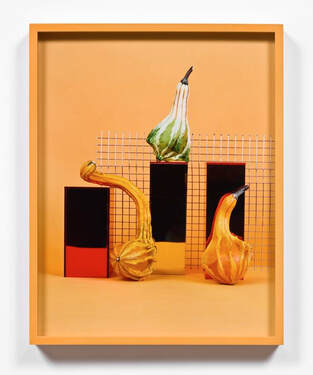Elad Lassry
Elad Lassry creates or rediscovers images from a vast array of sources, redeploying them in a variety of media, including photography, film, drawing and sculpture. Despite the diversity of his approach, Lassry has developed one of the most distinctive visual idioms in contemporary art and a rigorously focussed practice that investigates the nature of our perception and the meaning of the contemporary image.
Lassry describes his pictures, which are all exactly the same scale, as ‘something that’s suspended between a sculpture and an image’. The artist achieves this through a play of virtual and actual space. The image in each picture proposes a virtual space, while the frame, which is not a supplement to the image but an extension of it, carves out an actual space for the object to occupy. The images might be found – anything from a magazine snapshot to a Hollywood headshot – or photographed in studio conditions that reflect many of the concerns of traditional still life. Lassry then deploys the image as an ambiguous, free-floating signifier, which combines with the frame to create a new set of conditions. This hybrid entity becomes a kind of epistemological puzzle, engaging the viewer’s perceptual faculties. How does its objecthood affect our reading of the image? How does the subject matter of the image affect our perception of the object?
This disruptive play between image and object extends into his film and sculpture. In the 16mm film Zebra and Woman, the camera begins at the animal’s tail before panning across its striped hide, examining the nuances of colour and form as if it were a mid-century abstraction. Passing the animal’s head, the viewer is plunged, briefly, into blackness before the incongruous appearance of an attractive woman again dislocates the pictorial space. This set of conditions is typical of the artist’s concerns: close-looking, the indistinct space between abstraction and figuration, the combination of flatness and depth, all combining to examine how the mind reacts to different visual stimuli. Lassry brings this set of concerns to bear on a body of sculptural work based on cabinets that further explore a range of perceptual paradoxes. Produced on a scale that reflects the unchanging dimensions of his pictures, the cabinets look both utilitarian and ornamental, both a functional object and its representation.
Elad Lassry was born in Tel Aviv, Israel and he lives and works in Los Angeles. He has exhibited internationally including solo shows at San Francisco Museum of Modern Art, California (2020); Le Plateau, Paris (2018); Vancouver Art Gallery, Canada, curated by Jeff Wall (2017); Museum Boijmans Van Beuningen, Rotterdam (2014); Kunstnernes Hus, Oslo (2012); and Kunsthalle Zurich, Switzerland (2010). Group exhibitions include Walker Art Center, Minneapolis (2016); Solomon R. Guggenheim Museum, New York (2015); The Museum of Modern Art, New York (2014); Turner Contemporary, Margate, UK (2013); The Jewish Museum, Vienna (2012); 54th Venice Biennale (2011); The Photographers Gallery, London (2011); Aspen Art Museum, Colorado (2011); Sculpture Center, New York (2010); and New Museum, New York (2009).
Original bio from White Cube
Lassry describes his pictures, which are all exactly the same scale, as ‘something that’s suspended between a sculpture and an image’. The artist achieves this through a play of virtual and actual space. The image in each picture proposes a virtual space, while the frame, which is not a supplement to the image but an extension of it, carves out an actual space for the object to occupy. The images might be found – anything from a magazine snapshot to a Hollywood headshot – or photographed in studio conditions that reflect many of the concerns of traditional still life. Lassry then deploys the image as an ambiguous, free-floating signifier, which combines with the frame to create a new set of conditions. This hybrid entity becomes a kind of epistemological puzzle, engaging the viewer’s perceptual faculties. How does its objecthood affect our reading of the image? How does the subject matter of the image affect our perception of the object?
This disruptive play between image and object extends into his film and sculpture. In the 16mm film Zebra and Woman, the camera begins at the animal’s tail before panning across its striped hide, examining the nuances of colour and form as if it were a mid-century abstraction. Passing the animal’s head, the viewer is plunged, briefly, into blackness before the incongruous appearance of an attractive woman again dislocates the pictorial space. This set of conditions is typical of the artist’s concerns: close-looking, the indistinct space between abstraction and figuration, the combination of flatness and depth, all combining to examine how the mind reacts to different visual stimuli. Lassry brings this set of concerns to bear on a body of sculptural work based on cabinets that further explore a range of perceptual paradoxes. Produced on a scale that reflects the unchanging dimensions of his pictures, the cabinets look both utilitarian and ornamental, both a functional object and its representation.
Elad Lassry was born in Tel Aviv, Israel and he lives and works in Los Angeles. He has exhibited internationally including solo shows at San Francisco Museum of Modern Art, California (2020); Le Plateau, Paris (2018); Vancouver Art Gallery, Canada, curated by Jeff Wall (2017); Museum Boijmans Van Beuningen, Rotterdam (2014); Kunstnernes Hus, Oslo (2012); and Kunsthalle Zurich, Switzerland (2010). Group exhibitions include Walker Art Center, Minneapolis (2016); Solomon R. Guggenheim Museum, New York (2015); The Museum of Modern Art, New York (2014); Turner Contemporary, Margate, UK (2013); The Jewish Museum, Vienna (2012); 54th Venice Biennale (2011); The Photographers Gallery, London (2011); Aspen Art Museum, Colorado (2011); Sculpture Center, New York (2010); and New Museum, New York (2009).
Original bio from White Cube
